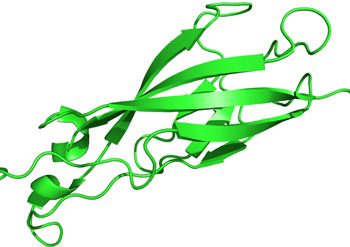Tumors Grow When Normal Cells Are Induced to Become Cancerous
By LabMedica International staff writers
Posted on 13 Dec 2015
A recent study determined how the cancer cells within a tumor promote its growth by transforming neighboring normal epithelial cells into cancer cells.Posted on 13 Dec 2015
In epithelial cancers, carcinoma cells coexist with normal cells. Although it was known that the tumor microenvironment played a pivotal role in cancer progression, it was not completely understood how the tumor influenced adjacent normal epithelial cells.

Image: Ribbon representation of a repeating unit in the extracellular E-cadherin ectodomain (Photo courtesy of Wikimedia Commons).
In a recent study, investigators at the University of Delaware (Newark, USA) employed a three-dimensional co-culture system comprising non-transformed epithelial cells (MDCK) and transformed carcinoma cells (MSV-MDCK) to demonstrate that carcinoma cells sequentially induced cancer-like changes, including preneoplastic lumen filling and epithelial–mesenchymal transition (EMT) in epithelial cysts.
The investigators found that at the molecular level, the protease MMP-9 (matrix metallopeptidase 9) secreted by carcinoma cells cleaved cellular E-cadherin from epithelial cells to generate soluble E-cadherin (sE-cad), a pro-oncogenic protein.
Cadherins are members of a family of calcium-dependent cell adhesion proteins that preferentially interact in a homophilic manner in cell-cell interactions. They are type I membrane proteins that contribute to the sorting of heterogeneous cell types. Typically, cadherins have five similar extracellular domains, the outermost three of which have Ca2+-binding sites, and an intracellular C-terminal domain that interacts with the actin cytoskeleton. Loss of E-cadherin function or expression has been implicated in cancer progression and metastasis. E-cadherin downregulation decreases the strength of cellular adhesion within a tissue, resulting in an increase in cellular motility. This in turn may allow cancer cells to cross the basement membrane and invade surrounding tissues.
In the current study, the investigators showed that sE-cad induced EGFR (epidermal growth factor receptor) activation, resulting in lumen filling in MDCK cysts, and that long-term sE-cad treatment induced EMT. Therefore, they were able to demonstrate that carcinoma cells could induce sE-cad shedding in adjacent epithelial cells, which led to EGFR activation and the eventual transdifferentiation of the normal epithelial cells.
Senior author Dr. Ayyappan Rajasekaran, adjunct professor of materials science and engineering at the University of Delaware, said, "This is the first time research has demonstrated that a cancer cell can sequentially induce early and late stages of cancer development in neighboring normal cells—a fundamental finding that can inform future studies. Like bacteria and viruses, cancer cells have the potential to infect normal cells and promote cancer progression. Future studies should give a new dimension to our understanding of cancer development and treatment."
Related Links:
University of Delaware













